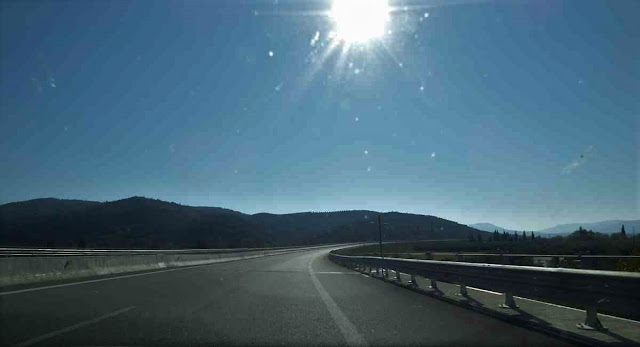DAY 6, Nov 14, 2018, Wednesday
We started off early on our drive. Our hotel had given us breakfast stuff the previous day at 6 pm when we did check out formalities. Their breakfast is only at 8 am. We were out by 7 am , leaving the key as they instructed.
This was our
route from Monodendri to Nafplio
450 km and around 5 hours drive was expected.
It was a pleasant drive, quite scenic.
Water was visible most of the route.
The Sun our erstwhile pal shone down benevolently on us
The blue sheet of water glimmered on one side. Driving in Greece was not just about getting from one place to another... it was FUN in itself!
The ubiquitous olive groves punctuated the landscape...
The electronic board proclaimed the date...
This was a pricey bridge... 13 euro toll. So we had water on both sides!
Then it was water on our left... the lovely Gulf of Corinth with its ink blue waters...
We were wondering how we can manage a drive on that side to enjoy the Gulf better... no scope in our tight schedule though... such a pity
We had neared our destination. Orange orchards appeared in plenty
NAFPLIO OLD TOWN:
Our accommodation was in Old Town. We roamed around clueless for a little while entering very tight lanes leading only to fields before figuring out where exactly we had to go.Parking is not allowed inside Old Town but we could drive in, deposit our bags.
There was a note on our door saying to contact the shop in front. The girl there showed us into our room up a flight of stairs. We paid up for our 3 night stay and finished our check out formalities also when we checked in.
It was a lovely neighborhood.
We parked our car at the port, 5 minutes walk away. Enjoyed the square and the sun set at the port
Statue is that of Kapodistrias, first
Governor of Greece.
Land Gate (Pyli Xiras) here...
Church of Agios Konstantinos, the Cathedral church of Nafplio
Our Accommodation, PENSION ISABO:

The room, though small, was comfortable and the common kitchen was just outside our door. Very convenient.

We had our meal and called it a day in lovely Nafplio
NAFPLIO:
The city takes its name from its founder, Nafplios, the son of Poseidon and Amimoni.
In ancient times Nafplio was overshadowed by Argos, which used it as a port from the 7th century BC.
Nafplio went through a series of occupations: first the Franks, then the Venetians followed by the Ottoman Turks.
During the first Venetian occupation towards the end of the 15th century, artificial banks were built into the sea to form the lower city. Until that time habitation had only been possible on the rock of the Acronauplia.
During the first Turkish occupation of the city, 1540 to 1686, Nafplio became the capitol of the Peloponnesus and the headquarters of the Turkish commander.
The second and harsher Turkish occupation began in 1715 and the city began to fall into decline, after the headquarters of the Pasha were moved to Tripoli. Many homes were abandoned; the harbor filled with rubbish and the stench was unbearable.
On the night of 29th November in 1822, after many months of siege, the Palamidi became independent as the result of a surprise attack led by the Greek Hero Staikos Staikopoulos. From then on, the city began to develop and crowds of refugees flooded in from the surrounding areas still under Turkish rule.
The city reached the peak of its glory when it became the capitol of the Greek state from 1827 to 1834. In 1834 the capitol of Greece was moved to Athens. Nowadays, Nafplio is a popular destination for Greek and foreign tourists.
This is the Church of Agios Konstantinos in the Old Town of Nafplio, the Cathedral church of Nafplio, just a minute's walk from our hotel.
We heard its sonorous bells frequently at our hotel room, but sadly never went in.
This is the Land Gate (Pyli Xiras)
Built in 1708, it is located on the road to Akronafplia and at the foot of the stone stairs of Palamidi. Long ago, it was the only entrance to the city by land as there was a moat filled with sea water in front of the gate and a wooden drawbridge, which was closed every night.
The marble statue is of the revolutionary hero Staikos Staikopoulos. Who liberated Greece from the Turks.
VIDEO LINK:
Nafplio Video is here:
Report of our visit to the magnificent ruins of Mystras continues here:



















































No comments:
Post a Comment